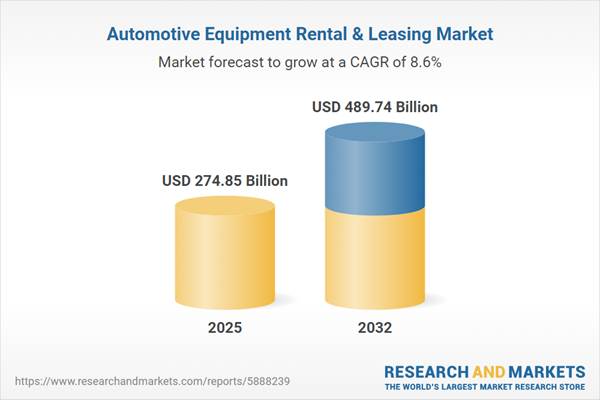Speak directly to the analyst to clarify any post sales queries you may have.
The automotive equipment rental and leasing market is experiencing notable changes as organizations adopt innovative technologies, redefine fleet strategies, and pursue more efficient operational models. Evolving customer preferences and digital advances are prompting companies to prioritize flexible, data-driven solutions and responsive service models.
Market Snapshot: Growth in the Automotive Equipment Rental & Leasing Market
The Automotive Equipment Rental & Leasing Market is advancing from USD 252.80 billion in 2024 to USD 274.85 billion in 2025, reflecting a robust CAGR of 8.61%. Projections indicate the market will reach USD 489.74 billion by 2032. Growth is influenced by increasing demand for adaptable fleet solutions, a rising inclination toward electrified vehicles, and a shift toward usage-based rental and leasing models among both commercial and consumer segments.
Scope & Segmentation of the Automotive Equipment Rental & Leasing Market
This comprehensive report delivers actionable insight for senior leaders navigating the evolving rental and leasing environment by breaking down key market segments across regions, asset categories, business channels, and user profiles.
- Equipment Type: Includes commercial vehicles—encompassing heavy and light duty trucks—specialized machinery for earthmoving and material handling, and diverse passenger vehicles ranging from basic to luxury classes. Each type presents distinct ownership, usage, and maintenance requirements.
- Rental Duration: Covers long-term arrangements (over six months, down to one-month intervals) and short-term rentals (daily or weekly), reflecting a spectrum of needs from project-based deployments to ongoing operational flexibility.
- End User Industry: Serves construction projects (both commercial and residential), event and leisure activities (concerts, sports, weddings), government and defense applications, and logistics and transportation needs for both intracity and intercity activity.
- Booking Channel: Encompasses offline channels, such as agent-managed and walk-in services, as well as online solutions including mobile apps and dedicated corporate websites. Digital platform adoption is a critical factor in capturing and retaining clients in an increasingly connected landscape.
- Fuel Type: Accounts for traditional (diesel, gasoline) and alternative powertrains (electric and hybrid), capturing the breadth of sustainability initiatives and emissions requirements informing fleet purchase decisions.
- Regions: Provides detailed analysis of the Americas, Europe, Middle East & Africa, and Asia-Pacific, with nuanced perspectives on both developed and emerging economies.
- Leading Companies: Profiles competitive leaders such as Enterprise Holdings Inc., Hertz Global Holdings Inc., Avis Budget Group Inc., Sixt SE, Europcar Mobility Group SA, AMERCO (U-Haul International Inc.), Penske Truck Leasing Co., L.P., Arval S.A., LeasePlan Corporation N.V., and ALD Automotive SA, offering strategic benchmarks for decision-makers.
Key Takeaways for Senior Decision-Makers
- Fleet flexibility is now a defining operational advantage, helping align asset availability with rapidly changing business demands and optimized financial performance.
- Accelerated integration of telematics and predictive maintenance enhances real-time monitoring while minimizing downtime and cost inefficiencies.
- Wider adoption of electric and hybrid fleets supports compliance initiatives and reflects greater commitment to sustainability and emissions standards.
- Enhanced digital platforms elevate user experience by enabling real-time bookings, streamlining fleet management, and providing valuable operational analytics for tailored service delivery.
- Segment-specific needs, such as increased maintenance for heavy commercial fleets or customized support for luxury vehicle users, require specialized contracting and attentive service models.
- Geographic and regulatory diversity requires leaders to adapt fleet strategies to local requirements and market trends, ensuring readiness and compliance across all regions.
Tariff Impact: Strategic Planning for 2025 and Beyond
Imminent adjustments to United States tariffs will influence how automotive rental and leasing companies approach sourcing, procurement, and pricing strategies. Leaders must explore domestic alternatives, adapt contract terms, and consider nearshoring options to manage risk and maintain competitive margins amid shifting trade conditions.
Methodology & Data Sources
The report is built on a rigorous mixed-methods framework, combining insights from direct interviews with industry executives and operations managers with systematic analysis of secondary materials. These include academic publications, government documents, and regulatory filings. Intensive data triangulation and expert review ensure accuracy and reliability of findings.
Why This Report Matters
- Enables senior executives to pinpoint the main drivers of profitability and operational efficiency to support refined fleet and asset strategies within the automotive equipment rental and leasing market.
- Delivers actionable insights on technology implementation, sustainability alignment, and the adoption of digital platforms to inform robust investment and planning decisions.
- Provides region-specific intelligence for effective market entry, expansion decisions, and risk mitigation tailored to unique regulatory and competitive environments.
Conclusion
As the automotive equipment rental and leasing sector transforms, strategic flexibility, technology adoption, and regulatory alignment are pivotal. Reliable, data-backed insights empower leaders to make informed decisions in a complex and evolving landscape.
Additional Product Information:
- Purchase of this report includes 1 year online access with quarterly updates.
- This report can be updated on request. Please contact our Customer Experience team using the Ask a Question widget on our website.
Table of Contents
3. Executive Summary
4. Market Overview
7. Cumulative Impact of Artificial Intelligence 2025
Samples

LOADING...
Companies Mentioned
The key companies profiled in this Automotive Equipment Rental & Leasing market report include:- Enterprise Holdings, Inc.
- Hertz Global Holdings, Inc.
- Avis Budget Group, Inc.
- Sixt SE
- Europcar Mobility Group SA
- AMERCO (U-Haul International, Inc.)
- Penske Truck Leasing Co., L.P.
- Arval S.A.
- LeasePlan Corporation N.V.
- ALD Automotive SA
Table Information
| Report Attribute | Details |
|---|---|
| No. of Pages | 190 |
| Published | October 2025 |
| Forecast Period | 2025 - 2032 |
| Estimated Market Value ( USD | $ 274.85 Billion |
| Forecasted Market Value ( USD | $ 489.74 Billion |
| Compound Annual Growth Rate | 8.6% |
| Regions Covered | Global |
| No. of Companies Mentioned | 11 |









